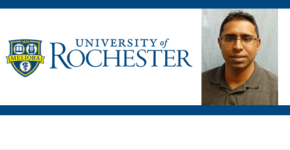 Muscle decay happens to the best of us as we age, but what if we could delay the inevitable?
Muscle decay happens to the best of us as we age, but what if we could delay the inevitable?
Joseph Chakkalakal, assistant professor in the department of orthopedics at the University of Rochester, looks into a possible new treatment to keep us stronger, longer.
Dr. Joe Chakkalakal is an Assistant Professor in the Department of Orthopaedics, Center for Musculoskeletal Research at the University of Rochester Medical Center. His laboratory is interested in the contribution of stem cells to the maturation, regeneration, and lifelong maintenance of skeletal muscle.
Through the use of conditional genetic strategies Dr. Chakkalakal’s lab has uncovered niche derived signals responsible for age-related decline of skeletal muscle resident stem cells. More recently, the Chakkalakal lab has found resident stem cell loss or gain is associated with earlier onset or attenuation of age-related skeletal muscle decline respectively. Dr. Chakkalakal’s lab is interested in building on these observations to 1) uncover how resident stem cell manipulation affects specific aspects of skeletal muscle biology in models of post-natal maturation, aging or accelerated aging, and 2) identify therapies that promote resident stem cell maintenance and function.
Stem Cells and Muscle Decay
As early as your mid 30’s, the size and strength of your muscles begins to decline. The changes are subtle to start – activities that once came easily are not so easy now – but by your 70’s or 80’s, this decline can leave you frail and reliant on others even for simple daily tasks.
While the speed of decline varies from person to person and may be slowed by diet and exercise, virtually no one completely escapes the decline. Even elite athletes will weaken with age and as modern medicine allows more people to live longer, this is becoming a more pressing issue.
In a recent study performed in mice, my research group discovered that muscle decline in old age is primarily driven by stem cells dying off in muscle. All adults have a pool of stem cells that reside in their muscle tissue. These stem cells spring into action during exercise or after injury – pumping out new muscle cells to repair or grow your muscles.
We already knew that muscle stem cells die off as you age, but our study was the first to suggest that stem cell loss is the main driving factor behind muscle decline. Previous theories suggested that age-related muscle decline was mainly caused by loss of motor neurons in the spinal cord, but we did not see evidence for this in our study.
We believe our results could change this field of research and lead to development of a new therapy that could help maintain the muscle stem cell pool and stave off muscle degeneration as long as possible. Our hope is to someday be able to improve those extra years of life – keeping people strong enough in their later years to still give their grandchildren piggyback rides, carry their own groceries, and maintain their independence.

Comments
One response to “Joseph Chakkalakal, University of Rochester – Stem Cells and Muscle Decay”